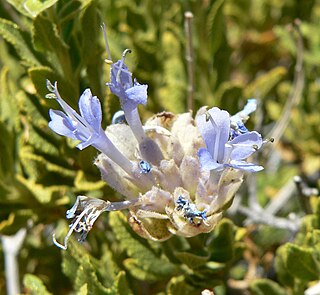
Salvia mohavensis is a species of sage endemic to the Mojave Desert. It is a low rounded shrub growing to 1 m tall with small opposite evergreen leaves 1.5–2 cm long, which are dark green or may appear nearly gray due to a covering of fine white hairs. The 2 cm long flowers are pale blue with protruding stamens, and occur in headlike whorls that occur singly at the tip of the stem. It blooms from April to June.

Caulanthus inflatus, the desert candle, also referred to as squaw cabbage, is a flowering plant in the family Brassicaceae, native to the Mojave Desert of California and Nevada, and the southern Sierra Nevada and Transverse Ranges in the United States. It is found at elevations between 150–1,500 metres (490–4,920 ft).

Chaenactis xantiana, the Mojave pincushion or Xantus pincushion, is a flowering plant in the family Asteraceae, native to the western United States, from southeastern Oregon, Nevada, southern and eastern California and northwestern Arizona. It is very common in the Antelope Valley in the Mojave Desert, and grows in sandy soils.

Monoptilon bellioides, the desert star, also called Mojave desertstar, is a desert flowering plant in the family Asteraceae.
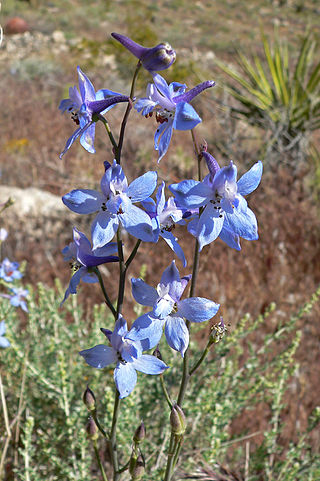
Delphinium parishii, the desert larkspur, is a flowering plant in the family Ranunculaceae native to the Mojave Desert, in the southwestern United States and northwest Mexico. In Southern California it is also found in the Tehachapi Mountains, Transverse Ranges, and eastern Sierra Nevada.

Calycoseris parryi, the yellow tackstem, is a spring wildflower found in the Mojave Desert, the Sonoran Desert, and surrounding regions of the southwestern United States and northwestern Mexico. It is found in California, Nevada, Utah, Arizona, and Baja California.

Layia platyglossa, commonly called coastal tidytips, is an annual wildflower of the family Asteraceae, native to western North America.
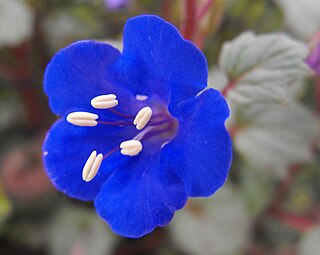
Phacelia campanularia is a species of flowering plant in the borage family, Boraginaceae, known by the common names desertbells, desert bluebells, California-bluebell, desert scorpionweed, and desert Canterbury bells. Its true native range is within the borders of California, in the Mojave and Sonoran Deserts, but it is commonly cultivated as an ornamental plant and it can be found growing elsewhere as an introduced species.
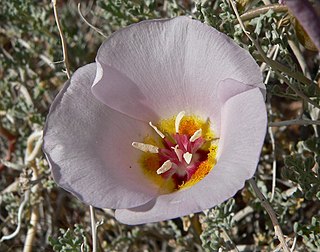
Calochortus flexuosus is a species of lily known by the common names winding Mariposa lily and straggling Mariposa lily.

Oenothera suffrutescens is a species of flowering plant in the evening primrose family known as scarlet beeblossom and scarlet gaura.

Malva parviflora is an annual or perennial herb that is native to Northern Africa, Europe and Asia and is widely naturalised elsewhere. Common names include cheeseweed, cheeseweed mallow, Egyptian mallow, least mallow, little mallow, mallow, marshmallow, small-flowered mallow, small-flowered marshmallowNafa Shak and smallflower mallow. It typically grows on agricultural lands and in disturbed sites such as roadsides.
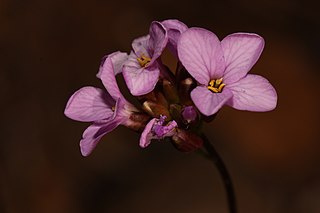
Arabis aculeolata is a species of flowering plant in the mustard family known by the common name Waldo rockcress.

Astragalus casei is a species of milkvetch known by the common name Case's milkvetch. It is native to the Mojave Desert and its sky island woodlands of eastern California and western Nevada.

Astragalus cimae is a species of milkvetch known by the common name Cima milkvetch. It is native to the Mojave Desert and its sky island woodlands of eastern California western Nevada, especially on calcareous soils, including the Cima Dome area in the Mojave National Preserve.
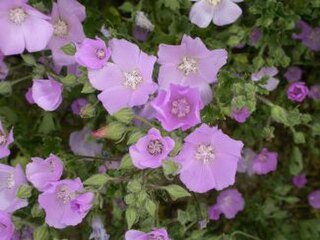
Eremalche parryi is a species of flowering plant in the mallow family known by the common name Parry's mallow.

Oenothera primiveris is a species of flowering plant in the evening primrose family known by the common names yellow desert evening primrose, bottle evening-primrose, and desert evening-primrose.
Prunus eremophila, also known by its common name Mojave Desert plum, is a rare species of plum native to California.

Funastrum cynanchoides, also known as fringed twinevine, twining milkweed or climbing milkweed, is a perennial plant in the family Apocynaceae that grows twining through other plants in the Mojave Desert and Sonoran Desert. It has milky sap and smells pungent. It is similar to Funastrum hirtellum.

Aliciella latifolia, also known as broad-leaved gilia, is a foul smelling annual plant in the Phlox family (Polemoniaceae) found in deserts of the southwestern United States.
Deiandra arida, also called Red Rock tarplant, is a rare California annual plant in the family Asteraceae.




















